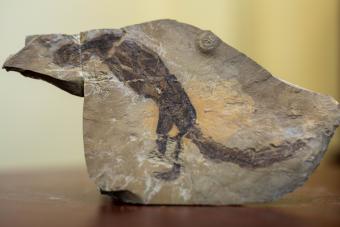Rare lizard fossil now on display at Mines Museum of Earth Science
The specimen was discovered somewhere along the Utah-Colorado border, likely during a school field trip in the early 1950s.

Photo by Vicknesh Balabaskaran, Colorado School of Mines
A rare lizard fossil with extremely well-preserved skin – and a tiny fossilized gnat keeping it company – is now on display at the Mines Museum of Earth Science.
The specimen was discovered somewhere along the Utah-Colorado border, likely during a school field trip in the early 1950s, but has never received its due until now.
The reason? For decades, everyone thought it was a leaf.
“When we uncovered the fossil again from our collections three years ago, we looked at it some more and said, ‘That doesn’t look like a plant to us.’ We decided we needed to have someone take a look at it,” said museum volunteer Dennis Gertenbach ‘74, MS ‘77, PhD ‘80. “The preservation is very, very unusual.”
Last year, Kenneth Carpenter, director and curator of paleontology at the Utah State University Eastern Prehistoric Museum in Price, Utah, correctly re-identified the fossil as a lizard due to the presence of scales. Ed Raines, collections manager of the Mines Museum of Earth Science, then discovered the gnat earlier this year.
The mix-up goes back more or less to the fossil’s discovery in sediments from ancient Lake Uinta, now known as the Green River Formation. According to museum records, the fossil was initially cataloged in the 1950s as a salamander, likely because of its flat head.
Then in the 1970s, someone from the University of Colorado took a gander and decided that no, the fossil was actually preserved plant material.
The fossils are preserved on a slab of mudstone, said Rick Sarg, research professor of geology and geological engineering at Mines. Both the lizard and the gnat are in quite remarkable condition. Scales are easily visible on the lizard’s skin, and the gnat’s wings and legs are also visible under magnification.
Ancient Lake Uinta was not a “normal” lake, Sarg said. Instead, it was alkaline, meaning that its waters had a pH of 9 to 12, with a near-saturation of sodium carbonate, sodium bicarbonate and calcium carbonate.
The pore spaces between the sand and silt grains of the sediments were full of these alkaline waters, Raines said. Additionally, the transition from mud to rock is a slow geologic process, as is the expulsion of pore water from the mud. So, a creature buried in the sediments would have soaked in these chemicals for centuries.
“Ironically, these are the very chemicals that the ancient Egyptians used to mummify their Pharaohs and other nobility,” Raines said. “Given the fact that each of Ancient Lake Uinta’s fossil lizards has reasonably well-preserved skin, it is fair to speculate that the lizard and the gnat were mummified as a first stage in the fossilization process.”




